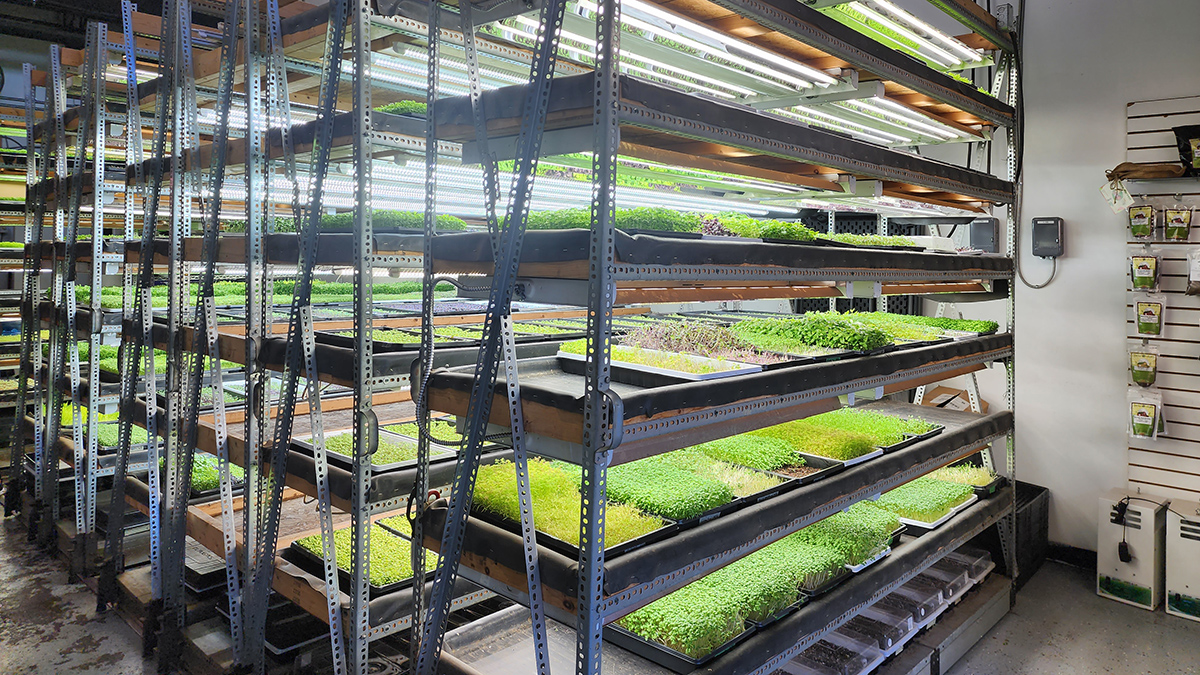Since the beginning of the global pandemic, trends have come and gone, from new TikTok dances to making foamed coffee. One trend — growing, selling, and cultivating microgreens — has put down firm roots in Ottawa.
“When I first started, there was one other microgreen producer in the Ottawa area, but now there’s three big guys, seven medium guys, and 50 little guys,” said Jace Baart, a local microgreen store owner and farmer.
Microgreens are small, edible vegetables that can be grown in a week to 21 days. They fall in between a sprout and and a baby green. Similar to baby greens, the stem and leaves are edible; however, they are smaller and take longer to grow than a sprout. Though the vegetables are one-to-three inches tall, they are said to have nutritional benefits, from vitamins to antioxidants.
With microgreens “you’re getting the most nutritious food … with a really low carbon footprint,” said Baart.
They’re also considered by many to be better for the environment than some more traditional foods. “Microgreens are more sustainable than crops grown to maturity on large industrial farms that use pesticides and chemicals as inputs, and are often transported hundreds of miles to market,” according to an article in GroCycle.
Baart, who started Microgreens Ottawa in 2013, grows his product in an indoor vertical farm year-round. Although microgreens can be cultivated faster than many traditional vegetables, they are expensive to cultivate, maintain and sell. “We’ve had to increase our costs to reflect our input costs,” said Baart.
One reason may be a rise in the cost of soil and seeds, but he also said that the rising popularity of people growing the tiny greens at home has taken a toll on his business. People see “a video on YouTube that told them they could make $2,000 a month working 10 hours,” but what they fail to consider are hydro costs, physical labour and even materials, Baart said.
Baart said about three people visit his shop a week asking questions about growing their own vegetables, taking pictures, and asking for advice. With more and more YouTube videos, TikToks and even articles in the New York Times, he has adapted his business model to include introductory classes on how to grow microgreens.
For consumers, the cost of microgreens depends on the vegetables you buy, where you buy and how many grams. At GoLokal, 65 grams of broccoli and 75 grams of red radish both cost $6 whereas at the Independent Grocer, 50 grams of micro arugula is $4.49. Though the price is similar to a full-size vegetable, as Healthline says, microgreens have a concentrated flavour and therefore fewer are needed in a dish, which may attract buyers.
According to a 2021 report by Agriculture and Agri-food Canada, the production of microgreens increased in 2018 and decreased in 2019-2021, when the pandemic began. But production remains well above 2017 levels.

Keshava Archibald is another Ottawa microgreen farmer. He sells his produce at the Ottawa Farmers Market with his brother. Archibald saw a video online discussing how simple cultivating microgreens in a confined space could be and was inspired to try it when he moved to a new farm “which had facilities to grow microgreens indoors … in the loft of our barn,” he said. Stable temperature is key to growing the veggies, he says.
In “one eight-foot area, you can end up getting over 2,000 pounds of greens in one year,” said Archibald. He also emphasized the nutritional benefits, saying “most microgreens are very high in vitamins, high in antioxidants, enzymes, protein …”
Archibald said he can continue to grow produce during winter that might be harder for many other farmers.
Though microgreens may seem like a good long-term and sustainable solution for many, Charles Levkoe, Canada’s research chair in sustainable and equitable food systems, said microgreens alone — and many other sustainable farming techniques — will not solve food security and sustainability issues. Levkoe said people need to look at “the systems and structures that make our food systems so unstable.”
Sustainability is “much more than the environment, we have to think of social aspects, economic aspects, aspects of justice,” Levkoe said. He said humans can’t survive off microgreens alone, and though microgreens or even garden towers can contribute to better food security, for some communities they are not viable or even part of their diet.
When “we come up with simple solutions to complex problems, we create worse problems,” said Levkoe.




